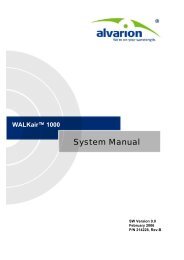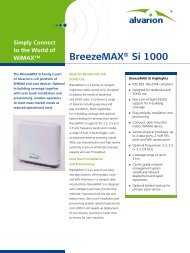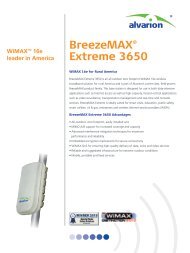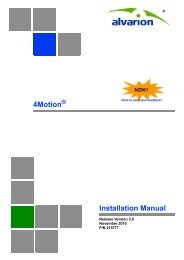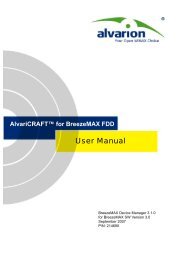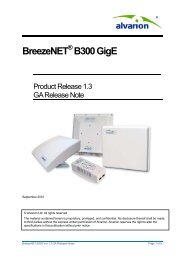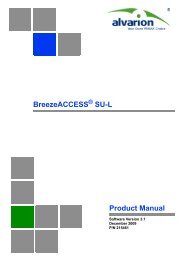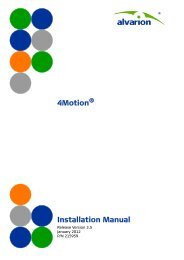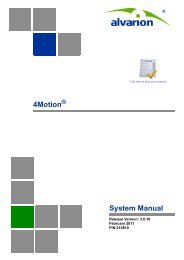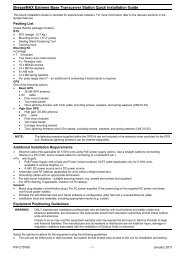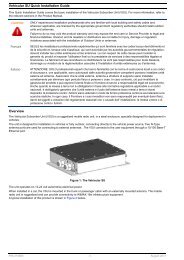BreezeMAX Si 2000 CPE User Manual - Alvarion
BreezeMAX Si 2000 CPE User Manual - Alvarion
BreezeMAX Si 2000 CPE User Manual - Alvarion
You also want an ePaper? Increase the reach of your titles
YUMPU automatically turns print PDFs into web optimized ePapers that Google loves.
Glossary<br />
Extensible Authentication<br />
Protocol (EAP)<br />
File Transfer Protocol<br />
(FTP)<br />
Hypertext Transfer<br />
Protocol (HTTP)<br />
IEEE 802.16e<br />
Local Area Network (LAN)<br />
MAC<br />
MAC Address<br />
Network Time Protocol<br />
(NTP)<br />
Orthogonal Frequency<br />
Division Multiplexing<br />
(OFDM)<br />
Power Over Ethernet (PoE)<br />
An authentication protocol used to authenticate network<br />
clients. EAP is combined with IEEE 802.1X port authentication<br />
and a RADIUS authentication server to provide “mutual<br />
authentication” between a client, the access point, and the a<br />
RADIUS server<br />
File Transfer Protocol: A TCP/IP protocol used for file transfer.<br />
Hypertext Transfer Protocol: HTTP is a standard used to<br />
transmit and receive all data over the World Wide Web.<br />
A standard that provides mobile broadband wireless access<br />
using Scalable Orthogonal Frequency Division Multiple Access<br />
(SOFDMA).<br />
Local Area Network: A group of interconnected computer and<br />
support devices.<br />
Media Access Control: The lower of the two sub-layers of the<br />
data link layer defined by the IEEE. The MAC sub-layer<br />
handles access to shared media, such as whether token<br />
passing or contention will be used.<br />
Standardized data link layer address that is required for every<br />
port or device that connects to a LAN. Other devices in the<br />
network use these addresses to locate specific ports in the<br />
network and to create and update routing tables and data<br />
structures. MAC addresses are 6bytes long and are controlled<br />
by the IEEE.<br />
NTP provides the mechanisms to synchronize time across the<br />
network. The time servers operate in a<br />
hierarchical-master-slave configuration in order to synchronize<br />
local clocks within the subnet and to national time standards<br />
via wire or radio.<br />
Orthogonal Frequency Division Multiplexing: OFDM allows<br />
multiple users to transmit in an allocated band by dividing the<br />
bandwidth into many narrow bandwidth carriers.<br />
Power over Ethernet: A specification for providing both power<br />
and data to low-power network devices using a single Category<br />
5 Ethernet cable. PoE provides greater flexibility in the locating<br />
of Wi²s and network devices, and significantly decreased<br />
installation costs.<br />
<strong>BreezeMAX</strong> <strong>Si</strong> <strong>2000</strong> <strong>CPE</strong> 126 <strong>User</strong> <strong>Manual</strong>




